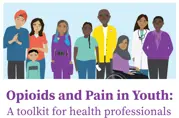Pediatric Pain Network

Opioids and Pain in Youth
A toolkit for health professionals
Co-created by SKIP and its partners, this toolkit summarizes current evidence and resources for safe, effective, and equitable opioid use in managing moderate to severe acute and chronic pain in youth. The information and resources in this toolkit can be integrated into clinical practice, support clinical education, and be used to inform organizational policies.
Pediatric Pain Management Practice and Policy Network
Children's Healthcare Canada and it's members, in partnership with Solution for Kids in Pain have been working nationally over many years in pursuit of solutions to shared issues with the research gap in children's pain assessment, treatment and management. Over the past several years we have focused on nurturing new knowledge, stimulating innovation, sharing research and information, and building on the expertise in the Canadian child health community.
Network Background
Virtually all children experience pain through commonly performed procedures (e.g., vaccination, blood tests, and laceration repair) within the healthcare system. These procedures occur at all levels of care (e.g., doctors’ office, clinics, hospitals, homecare settings), and are performed by a wide variety of health care professionals (e.g., nurses, doctors, paramedics, parents). Although there has been a significant amount of research in the area of improving pain treatment for children, there is evidence to suggest that interventions for painful procedures are not being used. Children’s pain remains undertreated in the Canadian healthcare system, and worldwide.
Proven and safe therapies are currently underutilized for routine minor, yet painful, procedures. Every health care facility caring for children should implement an effective pain prevention program that includes strategies for the following: routinely assessing pain; minimizing the number of painful procedures performed; effectively using pharmacological and non-pharmacological therapies for the prevention of pain associated with routine minor procedures; and eliminating pain associated with surgery and other major procedures.
Network Goals
The Pain Practice Network will provide a national forum for the child health community to convene to:
- Share information on current pain management processes.
- Collaborate on knowledge mobilization and project planning.
- Build awareness and uptake of the Health Standards Organization (HSO) Pediatric Pain Management Standard.
- Create and foster relationships between network members and Solutions for Kids in Pain (SKIP) Knowledge Brokers (KBs) to facilitate national knowledge mobilization and alignment.
- Participate as Subject Matter Experts to rebrand, refresh and update the Pediatric Pain Management Toolkit.
Meet the Network Co-Chairs:

Emily Synnott

Stephanie Paravan
Join the Network
Our Practice Networks are a member benefit and open to employees of all Children's Healthcare Canada's member organizations and the families they serve. If you would like to join this network, fill out the survey below.
Already a Network Member?
Access this networks meeting links, resources, discussion boards, and contact lists on the Children's Healthcare Canada Member Portal.
